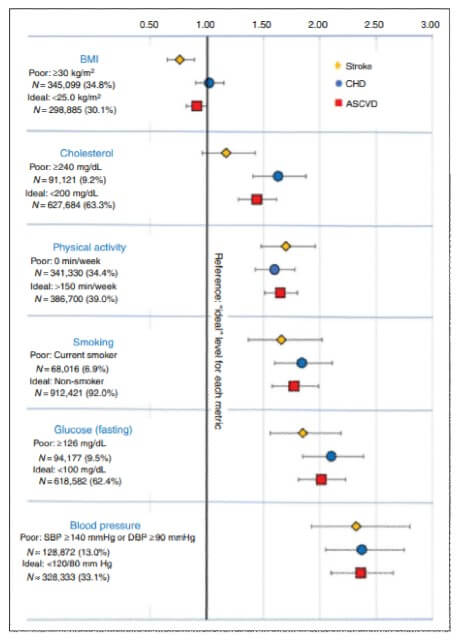
Lifestyle Targets for 1 million Heart Patients
10 years ago, the American Heart Association (AHA) set targets for heart health in their 2020 Impact Goal. So their aim was:
” By 2020, to improve the cardiovascular health of all Americans by 20% while reducing deaths from cardiovascular diseases and stroke by 20%.”[1]
Heart Patient Lifestyle Targets Purpose
My purpose in this article is to encourage heart patients to discuss lifestyle changes with their doctors. Because that can allow lifestyle to support medical treatments as part of a comprehensive heart care package. Note that this supports Purpose of Foodary.com. Which is to help you discuss your disease and diet concerns with health professionals.
Heart Patient Lifestyle Targets Report
The lifestyle target study investigates almost 1 million heart patients[2]. Starting with 7 factors that AHA has identified as important to heart health:
- Current smoking (smoker or nonsmoker)
- Body Mass Index (BMI)
- Physical activity
- Healthy diet score
- Total cholesterol
- Blood pressure
- Fasting plasma glucose
However factor 4 is not included in this study. Because diet scores are not routinely kept. So the other 6 factors were analyzed with respect to quality (poor vs. ideal).
Now, the report includes lots of data. Including splits between racial groups – Whites, Asians, Blacks, and Hispanics. Also, splits between types of cardiovascular disease – stroke (fatal and nonfatal), fatal coronary heart disease (CHD), and atherosclerotic cardiovascular disease (ASCVD). But they are beyond the scope of this summary. So I’ll focus on key targets. As shown by the risk chart from the report…

Figure 1. Risk of stroke, coronary heart disease and atherosclerotic cardiovascular disease by cardiovascular health metric categories (poor vs. ideal) among 991,698 patients.
In table form, the report data for heart patient lifestyle targets…
| Factor | Ideal | Poor |
|---|---|---|
| Body Mass Index (BMI) | <25.0 kg/m2 | ≥30 kg/m2 |
| Total cholesterol | <200 mg/dL | ≥240 mg/dL |
| Physical activity | >150 min/week | 0 min/week |
| Current smoking | Nonsmoker | Smoker |
| Fasting plasma glucose | <100 mg/dL | ≥126 mg/dL |
| Blood pressure | <120/80 mm Hg | SBP ≥140 mm Hg or DBP ≥90 mm Hg |
Heart Patient Weight Loss & Smoking
People have complained about these targets for being unrealistic. Especially smokers who find it impossible to quit without gaining weight. So that makes them feel the BMI targets are impossible.
But the reverse might be true. Because a 1999 trial shows that quitting smoking is more likely when you also adopt a low-calorie diet[3].
Results from that trial compared 2 groups of women who tried to stop smoking. They showed that without controlling diet 35% quit for 16 weeks and gained weight. But with diet control, 50% quit and lost weight. Then after a year, the dieting quitters were still ahead – 28% to 16%.
Combining the smoking cessation program with an intervention to control weight helped women to stop smoking and control weight.
Your Heart Patient Lifestyle Targets
As this report stresses the importance of all 7 identified targets as…
crucial physician-patient decision-making when it comes to addressing risks and benefits associated with each of the risk factors and overall cardiovascular health (CVH)
So you must discuss personal targets with your doctor. Because that’s the best way to assess those lifestyle changes that you need to make today.
Heart Patient Lifestyle Targets References
- Lloyd-Jones, Donald M., Yuling Hong, Darwin Labarthe, Dariush Mozaffarian, Lawrence J. Appel, Linda Van Horn, Kurt Greenlund, et al. “Defining and setting national goals for cardiovascular health promotion and disease reduction: the American Heart Association’s strategic Impact Goal through 2020 and beyond.” Circulation 121, no. 4 (2010): 586-613.
- Rana, Jamal S., Jennifer Y. Liu, Howard H. Moffet, Andrew J. Karter, Khurram Nasir, Matthew D. Solomon, Marc G. Jaffe, Andrew P. Ambrosy, Alan S. Go, and Stephen Sidney. “Risk of atherosclerotic cardiovascular disease by cardiovascular health metric categories in approximately 1 million patients.” European Journal of Preventive Cardiology (2020): 2047487320905025.
- Danielsson, Tobias, Kevin Jones, Stephan Rössner, and Åke Westin. “Open randomized trial of intermittent very low energy diet together with nicotine gum for stopping smoking in women who gained weight in previous attempts to quit commentary: results are unlikely to be as good in routine practice.” BMJ 319, no. 7208 (1999): 490-494.
